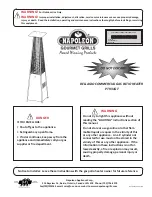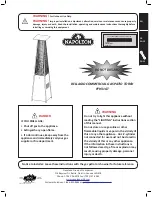
www.desatech.com
120163-01A
14
INSTALLATION
Continued
CHECKING GAS CONNECTIONS
WARNING: Test all gas piping
and connections for leaks after
installing or servicing. Correct
all leaks at once.
WARNING: Never use an
open flame to check for a leak.
Apply a noncorrosive leak detec
-
tion fluid to all joints. Bubbles
forming show a leak. Correct all
leaks at once.
CAUTION: Make sure ex
-
ternal regulator has been in
-
stalled between propane/LP
supply and heater. See guide
-
lines under
Connecting to Gas
Supply
, page 13.
PRESSURE TESTING GAS SUPPLY
PIPING SYSTEM
Test Pressures In Excess Of 1/2 PSIG
(3.5 kPa)
1. Disconnect appliance with its appliance main
gas valve (control valve) and equipment
shutoff valve from gas supply piping system.
Pressures in excess of 1/2 psig will damage
heater regulator.
2. Cap off open end of gas pipe where equipment
shutoff valve was connected.
3. Pressurize supply piping system by either
opening propane/LP supply tank valve for
propane/LP gas or opening main gas valve
located on or near gas meter for natural gas
or using compressed air.
4. Check all joints of gas supply piping system.
Apply noncorrosive leak detection fluid to all
joints. Bubbles forming show a leak.
5. Correct all leaks at once.
6. Reconnect heater and equipment shutoff
valve to gas supply. Check reconnected fit-
tings for leaks.
* Purchase the optional CSA design-certified
equipment shutoff valve from your dealer. See
Accessories
, page 26.
**Minimum inlet pressure for purpose of input
adjustment.
Figure 14 - Gas Connection
To Gas
Control
Valve
3" Minimum
Sediment Trap
Propane/LP
- From External
Regulator (11"
W.C.** To 14"
W.C. Pressure)
Natural
- From
Gas Meter (5"
W.C.**
To 10.5" W.C.
Pressure)
CSA Design-Certified
Equipment Shutoff Valve
With 1/8" NPT Tap*
Approved
Flexible Gas
Hose (if allowed
by local codes)
Tee
Pipe
Cap
Joint Nipple
We recommend that you install a sediment trap in
supply line as shown in Figure 14. Locate sediment
trap where it is within reach for cleaning. Install
in piping system between fuel supply and heater.
Locate sediment trap where trapped matter is not
likely to freeze. A sediment trap traps moisture and
contaminants. This keeps them from going into
heater controls. If sediment trap is not installed or
is installed wrong, heater may not run properly.
CAUTION: Avoid damage to
gas control. Hold gas control
with wrench when connecting it
to gas piping and/or fittings.















































